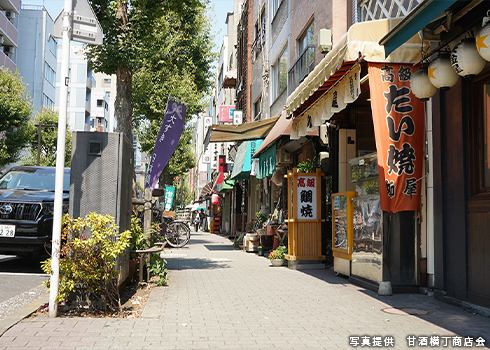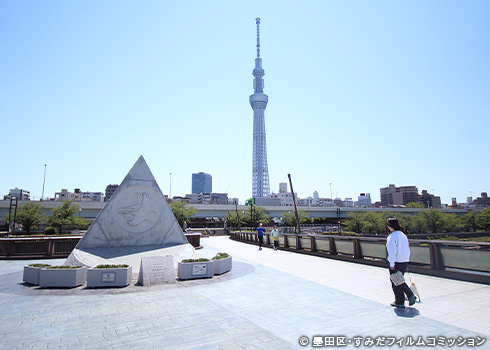Although Tokyo has sophisticated public transportation systems such as subways and other means, sometimes it is fun to go sightseeing on a bicycle while taking in the city's sights. The Joto area, which is dotted with sightseeing spots such as Nihonbashi and Asakusa, filled with the atmosphere of downtown Tokyo, is particularly ideal for bicycle tours, as it features many flat roads. Recently, there has been an increasing number of bicycle-sharing and other services that allow visitors to rent bicycles on the spot. We hope you will enjoy sightseeing in downtown Tokyo by bicycle while experiencing the atmosphere of the city and its seasonal scenery.
01.
05.
Start from Tokyo Station ➡ Around 10 minutes by bicycle ➡ Amazake Yokocho ➡ Around 9 minutes by bicycle ➡ Koto City Fukagawa Edo Museum ➡ 12 minutes by bicycle ➡ Former Yasuda Garden ➡ 12 minutes by bicycle ➡ Sakurabashi Bridge ➡ 6 minutes by bicycle ➡ Imado Shrine

Amazake Yokocho

A ten-minute bicycle ride from Tokyo Station will take you to Nihonbashi Ningyocho, an area that once flourished as the center of Edo (old Tokyo) and still retains its chic, old-fashioned downtown atmosphere. The 400-meter-long street that runs from Ningyocho Subway Station to the Meijiza Theater is known as “Amazake Yokocho,” and is lined with traditional craft stores and many long-standing stores that have been in business since the Edo period. There are many shops that have been serving sweet treats for over 100 years. During summer, visitors can savor soft ice cream and shaved ice to cool off, and during the colder months, warm up with hot taiyaki pancakes and amazake (sweet low-alcool or non-alcoholic drink) as they stroll along the downtown walkway. This is an ideal spot for taking a break from cycling.
Location: 2 Nihonbashi Ningyocho, Chuo-ku, Tokyo
http://amazakeyokocho.jp/

Koto City Fukagawa Edo Museum
From Amazake Yokocho, cross the Kiyosu Bridge over the Sumida River to Kiyosumi Shirakawa. Although the area is now known as a destination for coffee lovers, dotted with roasteries and cafés, it was originally a historic downtown area in Edo. The Koto City Fukagawa Edo Museum is definitely worth a visit if you are in the Kiyosumi Shirakawa area. The museum features a life-size reproduction of the Fukagawa Sagacho townscape from the late Edo period (Tenpo era), allowing visitors to learn how ordinary people lived during that period as if they were traveling back in time. English-language volunteer interpreters are also available, making it a great place for foreign travelers to visit.
Location: 1-3-28 Shirakawa, Koto-ku, Tokyo
https://www.kcf.or.jp/fukagawa/

Former Yasuda Garden
To get here, it takes about 12 minutes by bicycle from Kiyosumi Shirakawa heading north. The Former Yasuda Garden is located near the Ryogoku Kokugikan. The garden was built in the Genroku era (1688-1703) of the Edo period by a feudal lord and was once maintained as a tidal inlet garden where water was drawn from the nearby Sumida River and the water in the pond was kept under control by the ebb and flow of the tide. Today, the tidal inlet effect is artificially reproduced with the use of a pump. The garden, centering on the Shinji Pond, is adorned with seasonal flowers and trees such as hydrangeas and azaleas, allowing visitors to enjoy the natural scenery and watch wild birds such as ducks and herons.
Location: 1-12-1 Yokoami, Sumida-ku, Tokyo
https://visit-sumida.jp/spot/6085/

Sakurabashi Bridge

The Sakurabashi Bridge is the only one of the many bridges crossing the Sumida River that is not accessible to cars and is reserved for pedestrians and bicycles only. The bridge is shaped like the letter “X” and connects the Taito and Sumida sides of Sumida Park, which is noted for its excellent scenery. Here, visitors can take memorable photos from the bridge with the Tokyo Sky Tree in the background and enjoy the cherry blossoms that bloom along both banks of the Sumida River in spring. The sculptures standing at both ends of the bridge were carved by Yoshio Hosoi based on original paintings by the late Ikuo Hirayama, one of the greatest Japanese-style painters of all time. Visitors can stop their bicycles on the wide bridge and enjoy the view of the Sumida River at their leisure.
Location: 1-5 Mukojima, Sumida-ku, Tokyo
https://visit-sumida.jp/spot/6181/

Imado Shrine
A six-minute bicycle ride from Sakurabashi Bridge will take you to Imado Shrine. The shrine is said to be one of the places where lucky cats originated. Imado Shrine is where Soji Okita, the first leader of the Shinsengumi (small elite group of swordsmen commissioned by the bakufu), spent the last days of his life. Furthermore, since the shrine is dedicated to the god of matrimony, it is believed to bring good luck for matchmaking, fulfillment of love, and marital harmony. The temple grounds are dotted with lucky cat ornaments, and many good luck charms and other gifts with lucky cat motifs are on offer. Nami, a cat who has become the mascot of the temple, is a popular character there. If you actually get to meet Nami, your good fortune may improve even further.
Location: 1-5-22 Imado, Taito-ku, Tokyo
https://imadojinja1063.crayonsite.net/